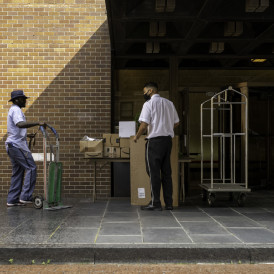Bed-bugged storage (Part 1): Is your stuff safe?

This weekend's NYT story about buying into a bed-bugged building (which we had something to do with) made us appreciate the fact that at least compared to renters, co-op and condo dwellers have the upper hand at squashing bed bug infestations: They control their own buildings, so they are better equipped (if not necessarily better informed) to fight the bugs at the critical building-wide level--and to make sure it’s done right.
Not so when renters get bed bugs. They are frequently at the mercy of apathetic and/or bed-bug illiterate landlords whose motivation to resolve the problem is compromised by the fact that they are not at personal risk of bedding down with the bugs. Nor are landlords eager to shoulder the entire cost of a responsible eradication plan.
Consequently, as the Great NYC Bed Bug Epidemic intensifies, so does renter diaspora.
Pest management experts (a.k.a. exterminators, as they no longer like to be called) say increasing numbers of desperate tenants are fleeing to what they hope are bug-free lodgings--and on their way out, stowing all their worldly belongings in a storage facility for 18 months, the amount of time a bed bug can survive without feeding.
That’s the same storage facility where your skis are summering, along with your winter wardrobe and the baby paraphernalia for your next kid.
"I had a client who was moving and put all her stuff in storage for six months, and when she took it out it was infested," says John Furman, the president of Boot-a-Pest, who was named the best bed bug exterminator by New York Magazine this year.
"People who aren't educated about bed bugs or don't think ahead will take their infested stuff and put it in storage, and the bugs will definitely move around random-searching for a host," he says.
Furman cites a lack of awareness among those who stash their infested belongings without wrapping and sealing them properly. “It’s dangerous because these people don’t realize what they’re doing,” he says.
Because bed bugs can survive for over a year without a blood meal, says Missy Henriksen, vp of public affairs for the National Pest Management Association in Fairfax, Virginia, "they can go into that nice dark place and have a vacation for six months. If they’re in one storage unit the chances are good they will actually climb into another one. They can go through walls and switch plates. That definitely is happening."
She notes that storage facilities with a higher proportion of commercial storage may be a somewhat safer bet.
“The more household items there are, the larger the chances there may be an infestation,” says Henriksen.
She recommends asking what they're doing to prevent infestations (like providing shrink-wrapping services and conduction inspections).
“Also ask them if they’ve had a problem and what was done," she says. "They should have brought in a professional to look at neighboring units above, below and beside.”
Still, while storage facilities are stepping up inspections, there doesn't seem to be much they can do short of fumigating all belongings on the way in. (Moving Right Along in Ozone Park, N.Y., actually does this for people battling bed bug infestations in their apartments.)
“Some storage facilities are sealing gaps and the like to prevent cross contamination,” says Gil Bloom, an entomologist who is the vice president of Standard Pest Management in Queens. “But the bottom line is that a
lot are open all the way up to the top and it's really hard to seal for roaming bed bugs.”
Tomorrow: Bed-bugged storage (Part II): How to protect your stuff
Don't miss Brick's BedbuggedNYC Meetup--Thurs., Sept. 15, 2011
Related links:
Bed-bugged storage (Part II): How to protect your stuff
NYC bed bug stats: A vast understatement?
$250,000 bed bugs online; another co-op goes to war
Brooklyn still #1 bed bug borough; Manhattan (UWS & North) next
Co-op hair-raiser: $250,000 bed bug bill
Your neighbor's bed bugs


























